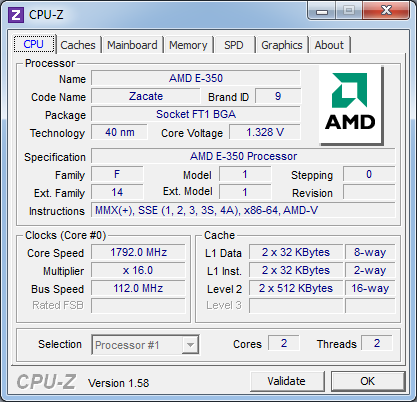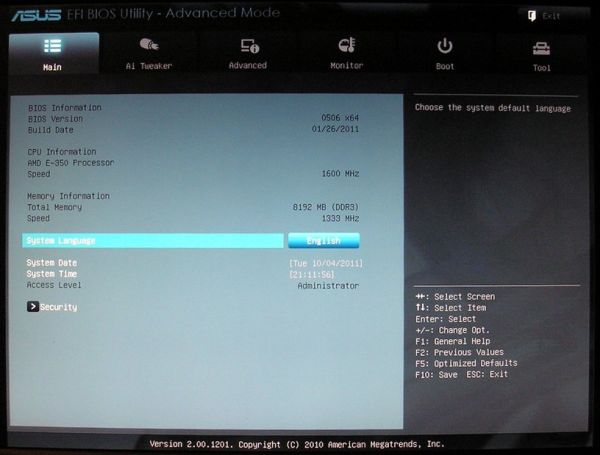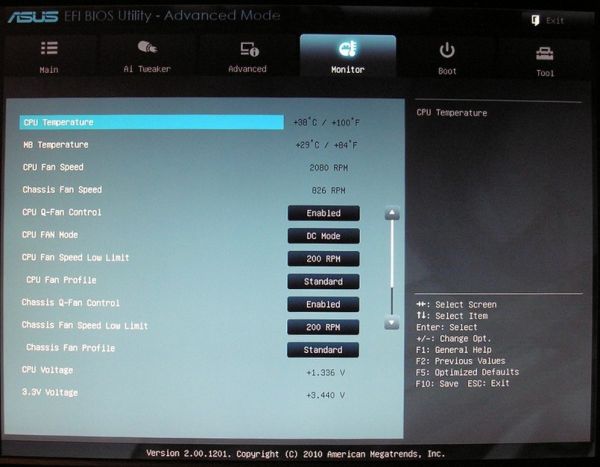ASUS E35M1-M Pro Review - Anyone For Fusion?
by Brendan van Varik on October 25, 2011 5:00 AM EST- Posted in
- Asus
- Motherboards
- Fusion
- E-350
BIOS
When you first enter BIOS, you will notice that ASUS have used a graphical BIOS with this motherboard. The BIOS itself is very easy to navigate through and when you get into it for the first time, you are faced with the ‘EZ Mode’ which shows you the basic things which a user may use or need to change such as the boot order of the system. When you enter the ‘Advanced Mode’, it opens up the entire BIOS so that you can turn things on or off which you would not find in the basic setup.
It is nice to see that overclocking features have been included in this BIOS but I do not think that many users will be buying this motherboard with overclocking in mind, as that will only raise power consumption and temperatures.
The fan controls in the BIOS allow you control both fan headers on the motherboard. You have a few options available which allow for either optimized cooling based on temperature, or if a quiet computing experience is preferred, that option is at your disposal too.
There are no noticeable changes between the release BIOS and the latest BIOS which is available on the ASUS website. ASUS claim improved system stability is achieved with the latest release although I have not experienced any issues on the shipped BIOS.
Overclocking
While overclocking may not be a strong point of this motherboard, it is still possible to squeeze a bit of extra performance out of the APU. I started with the ASUS Suite II software to see how good the automated overclocking was. The auto-overclocking feature added 3 MHz to the bus speed which increased the overall CPU speed by 48 MHz to give a final clock speed of 1648 MHz. The same overclock is applied if you select the AutoTune feature within the BIOS. It was stable but the increase in performance was not that noticeable.
Going through the BIOS, I was able to achieve a better result. The APU has a stock clock speed of 1.6 GHz and I was able to push it up to 1.792 GHz by using a 112 MHz base clock. All voltages were left on auto. When I went any higher than 112 MHz on the base clock, the motherboard would occasionally have an issue getting into Windows. However, from a stability standpoint, everything worked flawlessly at 112 MHz.

Along with standard stability tests, for completeness, the system was put under a 100 per cent loading for ten minutes and then the PC was put into a sleep state for the night. It switched on in the morning without any issues and full usability. When a 112 MHz base clock was used, there were no issues and the system was fully usable.


















66 Comments
View All Comments
mino - Wednesday, October 26, 2011 - link
IF not in a hurry, you better wait for a dual-core E2-series Llano.UrQuan3 - Wednesday, November 9, 2011 - link
I wish I had tested Netflix. 1080p youtube and 720p crunchyroll play fine, but flash has hardware acceleration on the E-350.Since I've gotten several 'free' Nexflix offers, maybe I should test it.
jacob733 - Tuesday, October 25, 2011 - link
What about the other SATA channels? It's nice to see throughput with a single SSD on a single channel, but all sorts of other effects come into play if you load all channels at once. For example my H55 board can be saturated even by LP class magnetic HDDs if I load all 6 channels due to channel sharing of some kind. Would be nice to know as apart from HTPC then E35M1-M Pro also looks perfect for homebrew NAS.firsthour - Tuesday, October 25, 2011 - link
Anyone have any experience running a FreeNAS box off this? I like the idea of the low power along with 5+1 SATA. Max 8GB memory is my only concern that I can think of, considering how hungry ZFS is.Anything else I should be concerned about? Is it worth waiting for an E-450 release?
mino - Wednesday, October 26, 2011 - link
AM3+ along with X2 240e is a far better choice for FreeNAS or simmilar- ECC
- excellent FullATX mobos with a bunch of slots for RAID/NIC's
fubird - Tuesday, October 25, 2011 - link
can I use i3-2100T and thermalright HR-02 to build a fanless system? Since I need 2 HDMI port and and the trend is lossless music file is becoming larger and larger, I don't think APU can handle that for a long run. That's why I prefer SB, but 0dB noise is a must.frozentundra123456 - Tuesday, October 25, 2011 - link
Why not test some older or less demanding games instead of Metro 2033 and Dirt?Both these games are clearly unplayable on this platform, so does a frame per second or two really make any difference?
Maybe try Sims 3, or Half Life 2, or KOTOR or Mass Effect, WoW or something. I cant think of any more specific games that might be actually playable, but I am sure there are a lot of games from the 2005 or so era that might still be fun and actually playable on this system.
Fradelius - Tuesday, October 25, 2011 - link
totally agree, testing crysis on this is not a wise ideawow on the other side.. works!
silverblue - Wednesday, October 26, 2011 - link
http://www.anandtech.com/show/4218/amds-brazo-e350...E-450 would mean a small improvement though not necessarily anything really measurable.
TSnor - Tuesday, October 25, 2011 - link
Article says "The operating system is installed on the OCZ Vertex 3 240GB SSD, which is rated at up to 550 MB/s read and up to 520 MB/s write, and the sequential test is run at the 5 x 1000 MB level on a separate clean partition. "BUT this doesn't work on a sandforce based SSD. The SSD does not respect partition boundaries, it pools all the flash memory to maximize performance and minimize wear. Write speed especially is a function of the size of the data PREVIOUSLY written to the part of the SSD that will be reused. Depending on whether or not the drive was previously written with large block writes (128K, 256K) or small (8K or less) block writes a sandforce controller can see a 2X write speed difference.
Net, I would not give much value to the comparative results of the SSD testing. The differences are probably not SATA port related.